Physical Address
304 North Cardinal St.
Dorchester Center, MA 02124
The contributions to this chapter by Dr. Lora Hedrick Ellenson, Department of Pathology, Memorial Sloan Kettering Cancer Center, New York City, New York, and Dr. Susan C. Lester, Department of Pathology, Brigham and Women's Hospital, Harvard Medical School, Boston, Massachusetts, in the previous edition of this book are gratefully acknowledged. We also appreciate Dr. Lester's assistance in the current edition.
The vulva is the external female genitalia and includes the hair-bearing skin (labia majora) and mucosa (labia minora). Disorders of the vulva most frequently are inflammatory; they are uncomfortable but not life threatening. By contrast malignant tumors of the vulva, although life threatening, are rare.
One of the most common causes of vulvitis is reactive inflammation in response to an exogenous stimulus, which may be an allergen or an irritant. Scratching-induced trauma secondary to the associated intense pruritus often exacerbates the primary condition.
Allergic dermatitis and contact irritant dermatitis result from a reaction to additives in lotions and soaps, antiseptics, and chemical treatments on clothing, among others, and appear as well-defined erythematous weeping and crusting papules and plaques. Urine may be a cause of contact dermatitis in the elderly.
Vulvitis may also be caused by infections, which are often sexually transmitted. The most important infectious agents include human papillomavirus (HPV), the causative agent of condyloma acuminatum, vulvar intraepithelial neoplasia (VIN) and a subset of vulvar squamous carcinomas; herpes simplex virus (HSV-1 or HSV-2), the cause of genital herpes; Neisseria gonorrhoeae, a cause of suppurative infection of the vulvovaginal glands; and Treponema pallidum, which causes primary chancre at vulvar sites of inoculation. Candida is also a cause of vulvitis but is not sexually transmitted.
An important complication of vulvitis is obstruction of the excretory ducts of Bartholin glands. This blockage may result in painful dilation of the glands (Bartholin cyst) and abscess formation.
Lichen sclerosus is characterized by thinning of the epidermis; disappearance of rete pegs; a zone of acellular, homogenized, dermal fibrosis; and a bandlike mononuclear inflammatory cell infiltrate ( Fig. 17.1 A ). Clinically, it presents as smooth, white plaques (leukoplakia) or papules that in time may extend and coalesce. When the entire vulva is affected, the labia become atrophic and stiffened, and the vaginal orifice is constricted. Lichen sclerosus occurs in all age groups but most commonly affects postmenopausal women and prepubertal girls. The pathogenesis is uncertain, but the presence of activated T cells in the subepithelial inflammatory infiltrate and the increased frequency of autoimmune disorders in affected women suggest an autoimmune etiology. The risk of vulvar squamous cell carcinoma is slightly increased in women with lichen sclerosus, although it is not itself a premalignant lesion.
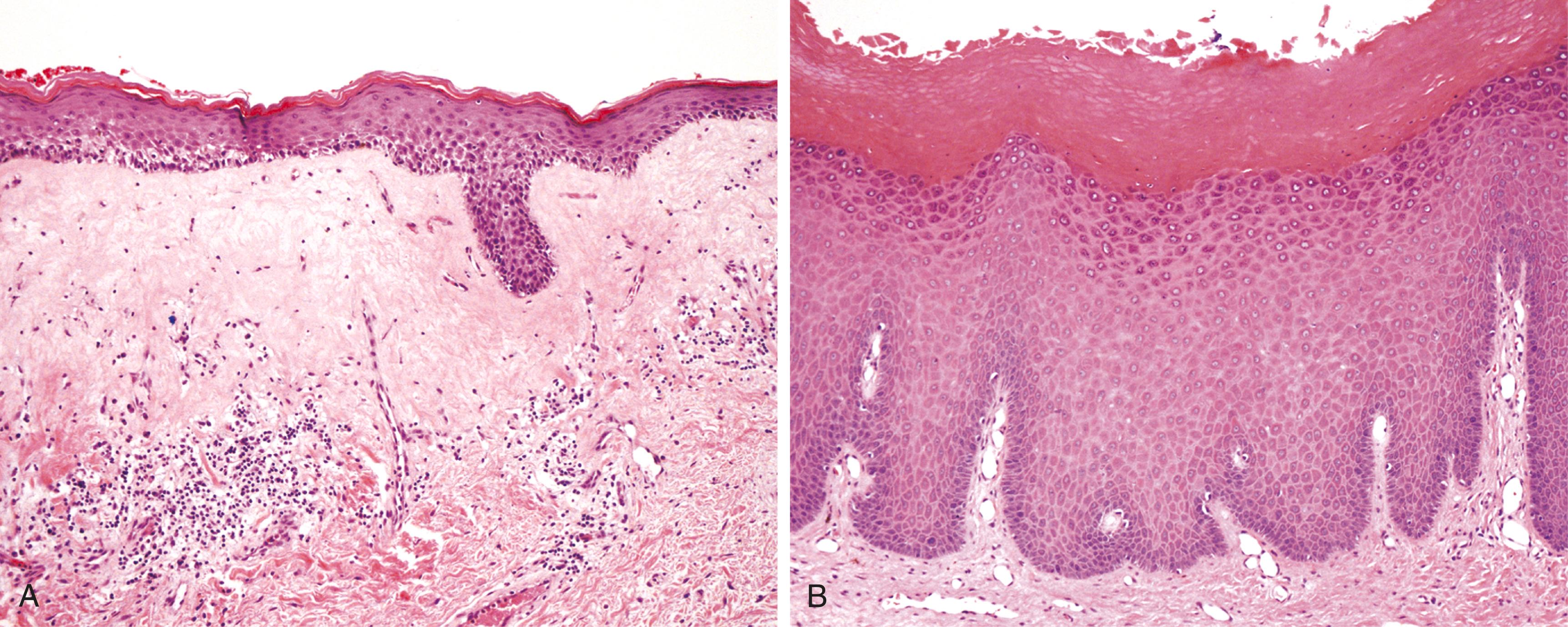
Previously called hyperplastic dystrophy or lichen simplex chronicus, squamous cell hyperplasia is a nonspecific condition resulting from rubbing or scratching of the skin to relieve pruritus. Clinically it presents as leukoplakia, and histologic examination reveals thickening of the epidermis (acanthosis) and hyperkeratosis ( Fig. 17.1 B). Lymphocytic infiltration of the dermis is sometimes present. The hyperplastic epithelium may show mitotic activity but lacks cytologic atypia.
A variety of other benign dermatoses, such as psoriasis and lichen planus ( Chapter 22 ), as well as malignant lesions of the vulva, such as squamous cell carcinoma in situ and invasive squamous cell carcinoma, may also present as leukoplakia. Thus, biopsy and microscopic examination are often needed to differentiate between these similar-appearing lesions.
Condylomas are warty lesions of the genitals that present in two distinctive forms, both of which are sexually transmitted. Condylomata lata, uncommonly seen today, are flat, minimally elevated lesions that occur in secondary syphilis ( Chapter 16 ). More common are condylomata acuminata, which are caused by low-risk HPV strains, mainly types 6 and 11; the lesions may be papillary and distinctly elevated or flat and rugose. They may occur anywhere on the anogenital surface as single or (more often) multiple lesions that are identical to those found on the penis and around the anus in males ( Chapter 16 ). When located on the vulva, they range from a few millimeters to many centimeters in diameter and are red-pink to pink-brown ( Fig. 17.2 A ). In darker skin, they may appear hyperpigmented. Histologically, they consist of papillary, exophytic cores of stroma covered by thickened squamous epithelium ( eFig. 17.1 ) with characteristic viral cytopathic changes (koilocytic atypia), which consist of enlarged, wrinkled nuclei; hyperchromasia, and a cytoplasmic perinuclear halo ( Fig. 17.2 B). Vulvar condylomas do not progress to cancer. However, women with condyloma acuminata are at risk of having other HPV-related precancerous lesions of the vagina and cervix. HPV vaccines (described later) provide excellent protection against infection by low-risk HPV and genital warts.
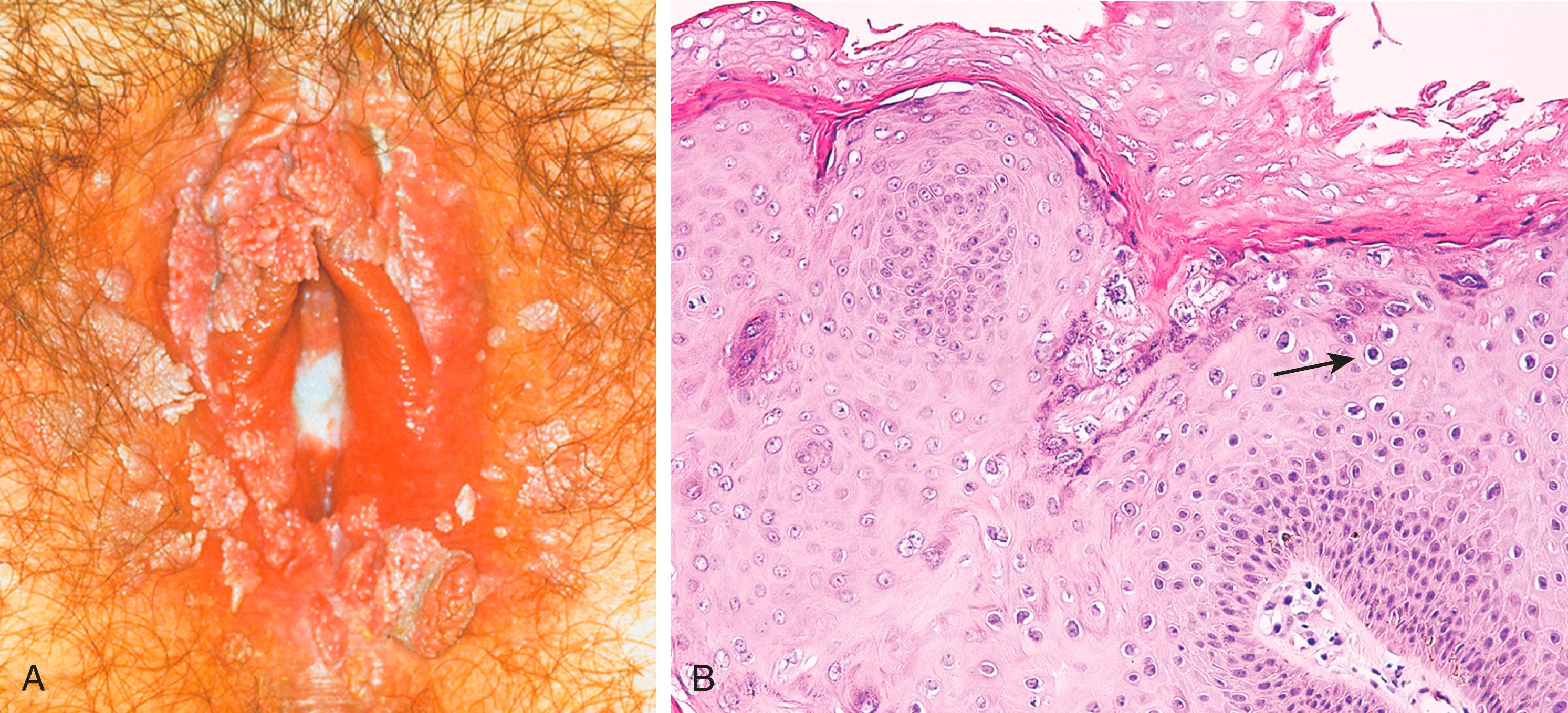
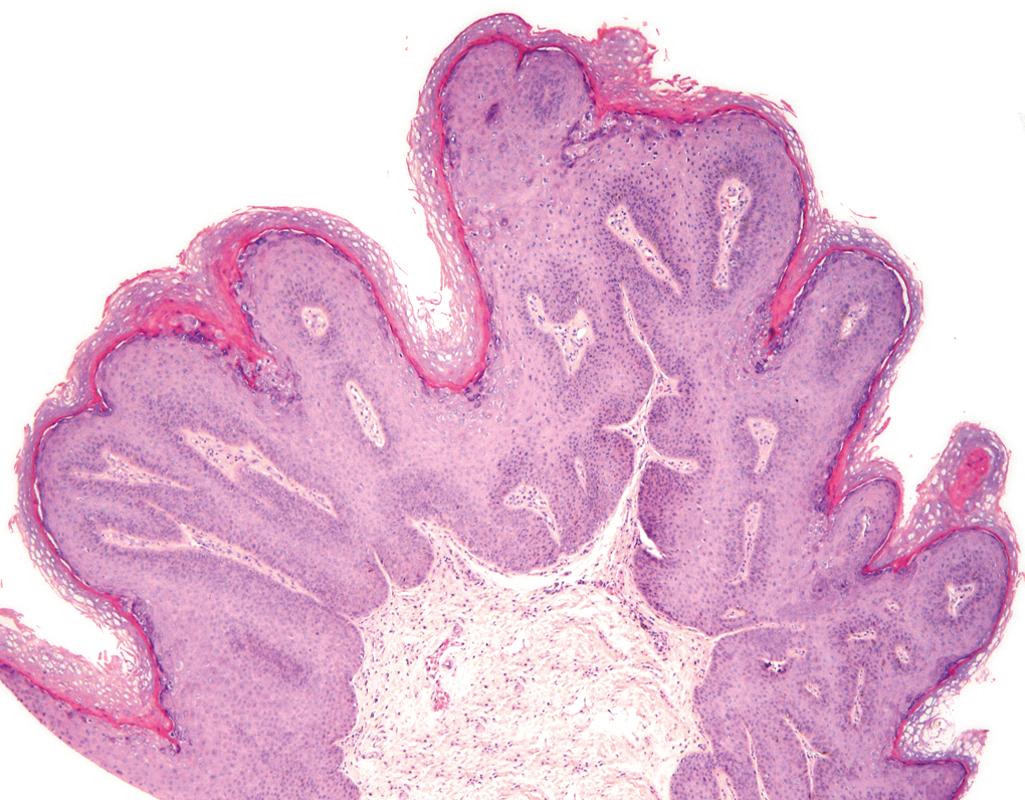
Carcinoma of the vulva represents about 3% of female genital tract cancers, occurring mostly in women older than age 60. Approximately 90% of carcinomas are squamous cell carcinomas; most of the other tumors are adenocarcinomas or basal cell carcinomas.
On the basis of etiology, pathogenesis, and histologic features, vulvar squamous cell carcinomas are divided into two groups. The less common form (basaloid and warty carcinoma) is related to high-risk HPV strains (especially HPV type 16) and occurs in women at an average age of 60 years, particularly in individuals who smoke. This form is often preceded by precancerous changes in the epithelium termed vulvar intraepithelial neoplasia (VIN). VIN progresses in many patients to greater degrees of atypia and eventually to carcinoma in situ; however, progression to invasive carcinoma is not inevitable and may take many years. The risk of progression to invasive carcinoma is higher in women who are older than 45 years of age or who are immunocompromised. The risk factors for VIN are the same as those associated with cervical squamous intraepithelial lesions (see later), as both are related to HPV infection.
A second form of squamous carcinoma (keratinizing squamous cell carcinoma) occurs in older women (average age 75 years) with long-standing lichen sclerosus or squamous cell hyperplasia and is not related to HPV. It is preceded by differentiated vulvar intraepithelial neoplasia (dVIN), characterized by abnormal keratinization and cytologic atypia confined to the basal layer. If left untreated, it may give rise to HPV-negative, well-differentiated, keratinizing squamous cell carcinoma. It is postulated that the chronic epithelial irritation and associated increase in cell turnover that occurs in lichen sclerosus or squamous cell hyperplasia contribute to the malignant phenotype, presumably by fostering the acquisition of driver mutations in oncogenes and tumor suppressor genes.
VIN and early vulvar carcinoma commonly presents as areas of leukoplakia. In about one-fourth of the cases, the lesions are pigmented due to the presence of melanin. With time, areas of leukoplakia are transformed into overt exophytic or ulcerated endophytic tumors. HPV-positive tumors are often multifocal and warty and tend to be poorly differentiated squamous cell carcinomas, whereas HPV-negative tumors are usually unifocal, well-differentiated keratinizing squamous cell carcinomas.
Both forms of vulvar carcinoma tend to remain confined to their site of origin for many years but ultimately invade and spread, usually first to regional lymph nodes. Ultimately, hematogenous spread to the lungs and other organs may occur. As with most carcinomas, outcome is dependent on tumor stage: the risk of metastasis correlates with the depth of invasion and tumor size.
Paget disease is an intraepidermal proliferation of atypical epithelial cells that can occur in the skin of the vulva or nipple of the breast (described later). In contrast to Paget disease of the nipple, which is always associated with an underlying ductal breast carcinoma, only a minority of cases of vulvar (extramammary) Paget disease have an underlying tumor. Instead, vulvar Paget cells most commonly appear to arise from multipotent cells found within the ducts of the vulvar skin.
Paget disease manifests as a red, scaly, crusted plaque that may mimic the appearance of dermatitis. On histologic examination, large cells with abundant pale, finely granular cytoplasm and occasional cytoplasmic vacuoles infiltrate the epidermis, singly and in groups ( Fig. 17.3 ).
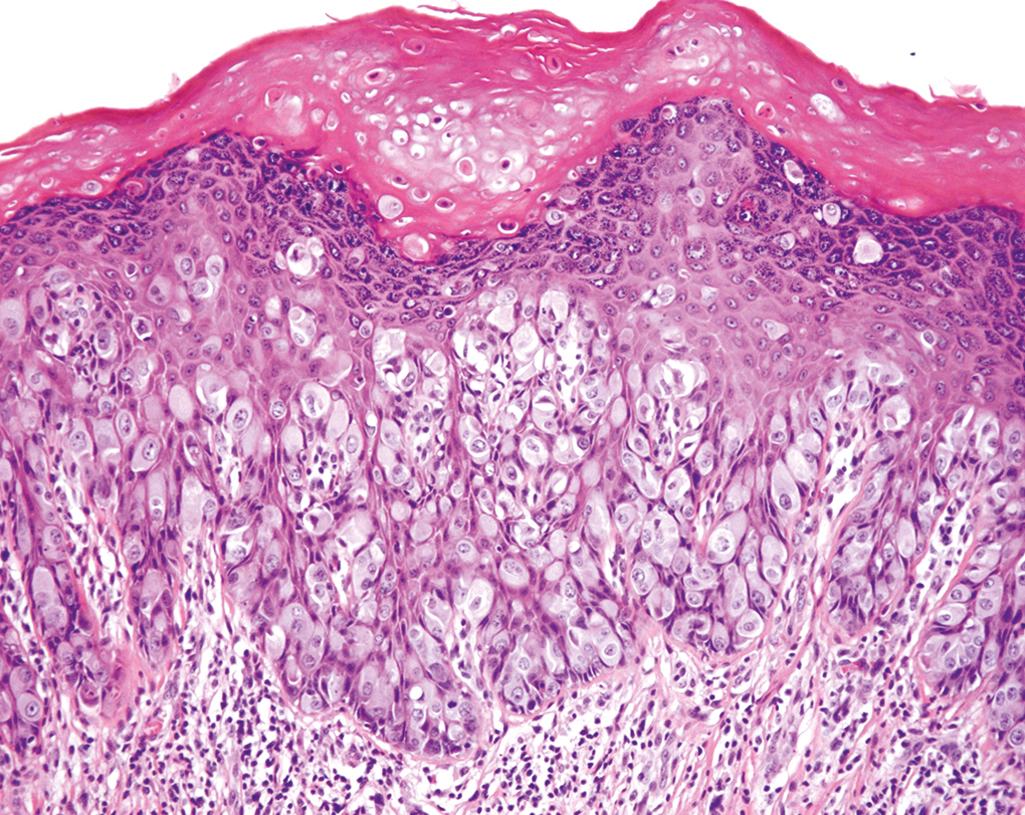
Intraepidermal Paget disease may persist for many years or even decades without invasion or metastases. Treatment consists of wide local excision. In the rare instances when invasion develops, the prognosis is poor.
In adults, the vagina is seldom a site of primary disease; more often, it is involved secondarily by cancer or infections arising in adjacent organs (e.g., cervix, bladder, rectum).
Congenital anomalies of the vagina are uncommon and include total absence of the vagina and a septate or double vagina (usually associated with a septate cervix and, sometimes, septate uterus), and lateral Gartner duct cysts arising from persistent wolffian duct rests.
Vaginitis secondary to infection is a common condition that is usually transient and is associated with a vaginal discharge (leukorrhea). Infectious agents include bacteria, fungi, and parasites. Many are normal commensals that become pathogenic only in the setting of diabetes, systemic antibiotic therapy (which disrupts normal microbial flora), immunodeficiency, pregnancy, or recent abortion. Frequent pathogenic organisms include Candida albicans , Trichomonas vaginalis, and Gardnerella vaginalis. C. albicans is part of the normal vaginal flora in about 20% of women; symptomatic infection almost always involves one of the predisposing influences listed above or superinfection by a new, more aggressive strain. Candidal vaginitis is characterized by a thick white discharge containing hyphal forms that can be identified on a Papanicolaou test ( eFig. 17.2 ). Worldwide, T. vaginalis is the most common nonviral sexually transmitted infection. Infection is often asymptomatic but can produce a copious, watery, gray-green discharge in which parasites can be identified by microscopy ( eFig. 17.3 ). G. vaginalis is a gram-negative coccobacillus that is implicated as the main cause of bacterial vaginosis . Patients present with a thin, malodorous discharge within which are found "clue cells," squamous cells covered with a shaggy coat of coccobacilli.

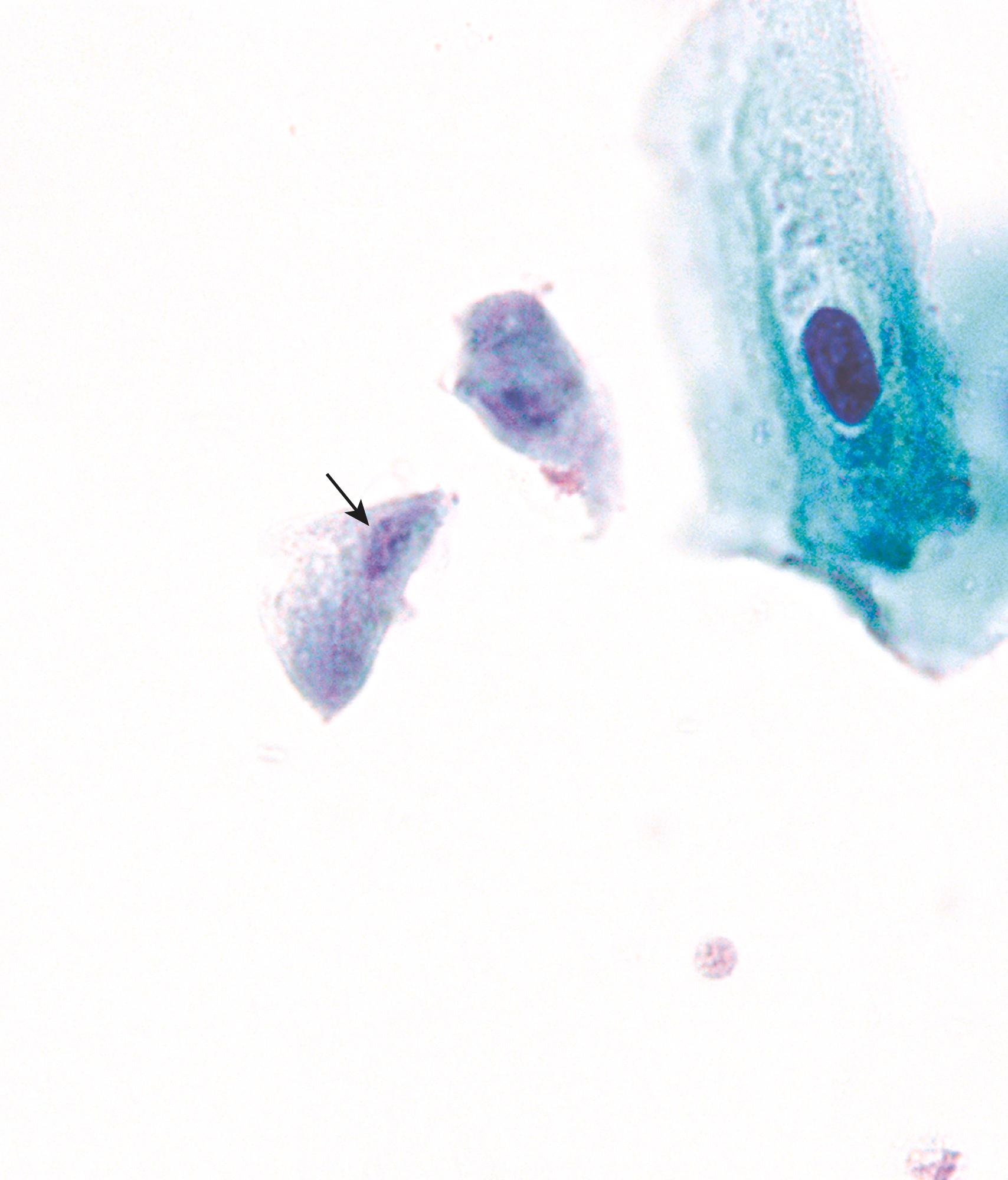
Vaginal carcinoma is extremely uncommon and arises from vaginal intraepithelial neoplasia (VAIN), a precursor lesion analogous to cervical squamous intraepithelial lesion (see later). Virtually all primary carcinomas of the vagina are squamous cell carcinomas associated with high-risk HPV infection. The greatest risk factor is a previous carcinoma of the cervix or vulva. Most often the invasive tumor affects the upper vagina, particularly the posterior wall at the junction with the ectocervix, and tends to spread to regional iliac nodes.
Also called sarcoma botryoides, this rare vaginal tumor composed of malignant embryonal rhabdomyoblasts is most frequently found in infants and children younger than 5 years of age. It may also be found in other sites, such as the urinary bladder and bile ducts. It is discussed further with other soft tissue tumors in Chapter 19 .
The majority of cervical lesions are inflammatory (cervicitis). Cervical squamous cell carcinoma is one of the most common cancers in women worldwide.
Inflammatory conditions of the cervix are extremely common and may be associated with a purulent vaginal discharge. Cervicitis can be subclassified as infectious or noninfectious, although differentiation is difficult due to the presence of normal vaginal flora, including incidental vaginal aerobes and anaerobes, streptococci, staphylococci, enterococci, and Escherichia coli and Candida spp.
Sexually transmitted organisms, such as Chlamydia trachomatis, Ureaplasma urealyticum, T. vaginalis, Neisseria gonorrhoeae, HSV-2 (the agent of genital herpes), and certain types of HPV, can cause significant morbidity. C. trachomatis is by far the most common of these pathogens, accounting for as many as 40% of cases of cervicitis encountered in sexually transmitted disease clinics. Although less common, herpetic infections are noteworthy because maternal–infant transmission during childbirth may result in serious, sometimes fatal systemic herpetic infection in the newborn.
Cervicitis may come to attention on routine examination or due to leukorrhea. Treatment is usually empiric with antibiotics that are active against chlamydia and gonococcus. In some instances, nucleic acid amplification tests are used on vaginal fluid to identify the presence of these organisms as well as Trichomonas vaginalis .
Endocervical polyps are common benign exophytic growths that arise within the endocervical canal. They vary from small, sessile “bumps” to large polypoid masses that may protrude through the cervical os. Histologically, they consist of a fibrous stroma covered by mucus-secreting endocervical glands, often accompanied by inflammation. Their main significance is that they may be the source of irregular vaginal bleeding due to ulceration that arouses suspicion of an ominous lesion. However, these lesions have no malignant potential, and simple curettage or surgical excision is curative.
The vast majority of cervical tumors are carcinomas caused by oncogenic strains of HPV. The columnar mucus-secreting epithelium of the endocervix meets the squamous epithelial covering of the ectocervix at the squamocolumnar junction, the precise location of which varies with age and hormonal status. At puberty, the squamocolumnar junction undergoes eversion, and the columnar epithelium shifts outward to the ectocervical surface. The exposed columnar cells undergo squamous metaplasia, forming a region called the transformation zone. Immature squamous cells in this region are most susceptible to HPV, and this is where tumors most commonly arise ( Fig. 17.4 ).
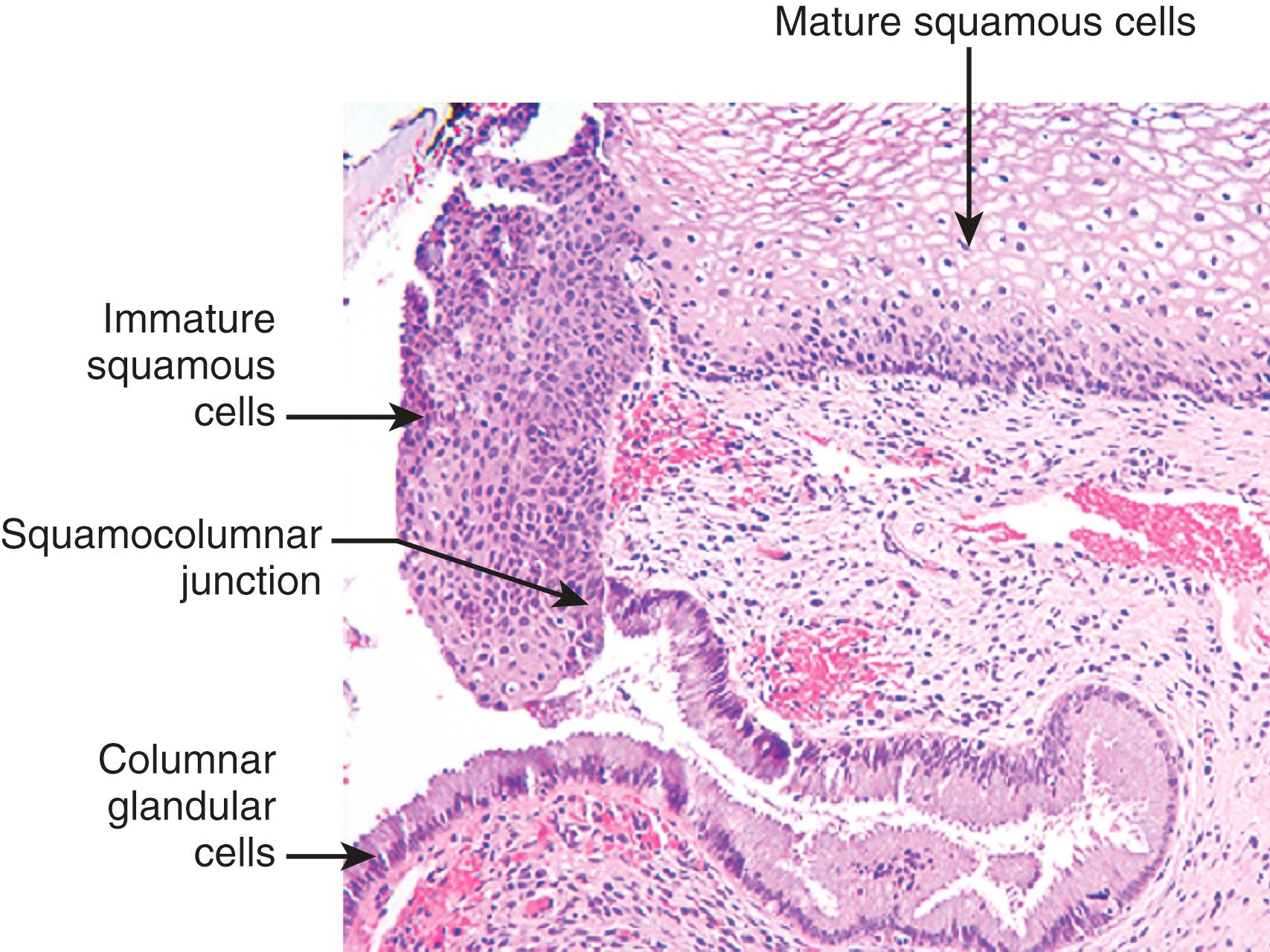
High-risk HPVs are by far the most important factor in the development of cervical cancer. HPVs are DNA viruses that are grouped into high and low oncogenic risk based on their genotypes. High-risk HPVs are also implicated in squamous cell carcinomas arising at many other sites, including the vagina, vulva, penis, anus, tonsil, and other oropharyngeal locations. Most HPV infections are transient and are eliminated within months by the host immune response. The duration of the infection is related to HPV type: infections with high-risk HPVs take longer to clear on average than infections with low-risk HPVs. Persistent infection increases the risk of development of cervical precursor lesions and subsequent carcinoma. Important risk factors for the development of cervical intraepithelial neoplasia (CIN) and invasive carcinoma are directly related to HPV exposure and include early age at first intercourse, multiple sexual partners, partner with multiple previous sexual partners, and persistent infection by high-risk strains of HPV.
The ability of HPV to act as a carcinogen depends on the viral E6 and E7 proteins, which interfere with the activity of the key tumor suppressor proteins, p53 and RB, respectively. Although HPV infects immature squamous cells, viral replication occurs in maturing squamous cells. Normally, these more mature cells are arrested in the G 1 phase of the cell cycle, but HPV infection prevents the growth arrest of these cells, an effect that is essential for replication of the viral genome and for productive shedding of virus. Two early viral proteins, E6 and E7, are prooncogenic: E6 binds to and mediates destruction of p53 and upregulates telomerase expression while E7 binds to the RB protein, displacing the E2F transcription factors that are normally sequestered by RB and promoting progression through the cell cycle ( Chapter 6 ).
Two high-risk HPV viruses, types 16 and 18, account for approximately 70% of cases of cervical intraepithelial neoplasia (CIN) and cervical carcinoma ( Fig. 17.5 ). These HPV types also show a propensity to integrate into the host cell genome, an event that is linked to progression. In low-risk HPV variants (e.g., types 6 and 11) associated with the development of condylomas of the lower genital tract, the E7 proteins bind RB with lower affinity and the E6 proteins fail to bind p53 altogether and instead appear to dysregulate growth and survival by interfering with the Notch signaling pathway. Furthermore, low-risk HPV variants do not integrate into the host genome, remaining instead as free episomal viral DNA. Viral integration by high-risk HPVs appears to contribute to transformation in two ways: (1) integration always disrupts an HPV gene that negatively regulates E6 and E7, which leads to their increased expression, and (2) integration is associated with increased genomic instability, which may contribute to the acquisition of additional prooncogenic mutations.
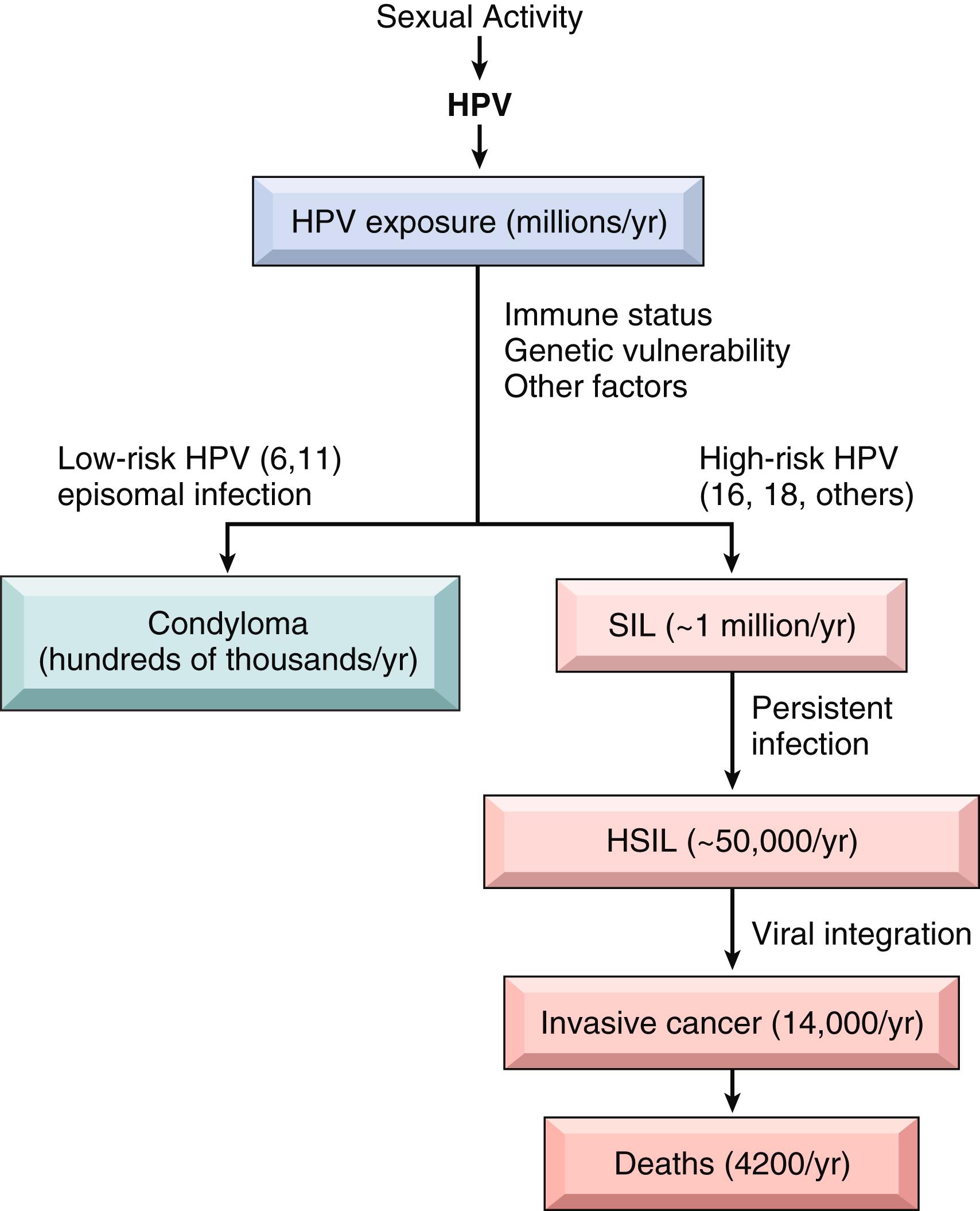
Despite a high incidence of infection with one or more HPV types during the reproductive years, only a small number of individuals develop cancer. Thus, other factors, such as exposure to cocarcinogens (e.g., cigarette smoking) and host immune status, influence whether an HPV infection regresses or persists and eventually leads to cancer.
HPV-related carcinogenesis begins with the precancerous epithelial change termed SIL, which usually precedes the development of an overt cancer by many years, sometimes decades. In support of this idea, SIL peaks in incidence at about 30 years of age, whereas invasive carcinoma peaks at about 45 years of age.
The classification of cervical precursor lesions has evolved over time. Clinical management is based primarily on a two-tier system (low-grade SIL, LSIL; high-grade SIL, HSIL) that reflects the biology of the disease; however a three-tier system (CIN I, CIN II, and CIN III) plays a role in some treatment decisions.
In the two-tier system, LSIL corresponds to CIN I and HSIL encompasses CIN II and III.
LSIL is far more common than HSIL. Most cases of LSIL regress spontaneously, but a small percentage progress to HSIL. In LSIL, there is a high level of viral replication and only mild alterations in the growth of the host cells. LSIL is not considered a premalignant lesion.
HSIL demonstrates increased proliferation, arrested epithelial maturation, and lower levels of viral replication. It has a high risk for progression to carcinoma.
While HSIL is precancerous, in the majority of cases it does not progress to cancer, and some cases even regress. Risk factors for progression include cigarette smoking and immunocompromise, the latter suggesting that immune surveillance plays a role in preventing progression. Although the majority of HSILs develop from LSILs, approximately 20% of cases of HSIL develop de novo, independent of any known preexisting LSIL.
Because of the differences in the natural histories of these two groups of lesions ( Table 17.1 ), optimal patient management depends on accurate diagnosis. Cervical precancerous lesions are associated with abnormalities in cytologic preparations that can be detected long before any abnormality is visible on gross inspection. Early detection of SIL is the rationale for the Papanicolaou (Pap) test, in which cells are scraped from the transformation zone and examined microscopically. The Pap test is the most successful cancer-screening test developed to date. Fifty years ago, carcinoma of the cervix was the leading cause of cancer death in women in the United States, but the death rate has declined by 75% to its present rank as the thirteenth cause of cancer mortality. By contrast, in countries with low-level screening with the Pap test, cervical cancer incidence remains high, with more than 85% of new cases being diagnosed in resource-limited countries. This disparity is also seen in cervical cancer mortality: the age-standardized mortality rate in lower- and middle-income countries is 12.4 per 100,000, compared to 5.2 per 100,000 in higher-income countries.
| Lesion | Regress | Persist | Progress |
|---|---|---|---|
| LSIL (CIN I) | 60% | 30% | 10% (to HSIL) |
| HSIL (CIN II, III) | 30% | 60% | 10% (to carcinoma) a |
Testing for the presence of HPV DNA in cervical scrapes is a complementary molecular method of cervical cancer screening. HPV testing is highly sensitive for the identification of high-risk HPV types. It is most useful in women 30 years of age or older, since patients with a negative high-risk HPV test at this age are extremely unlikely to develop cervical neoplasia within the next 5 years. HPV testing of women younger than 30 years of age is less useful because of the high incidence of infection in this age group, lowering the predictive value of the HPV test for the presence of cervical neoplasia. Furthermore, while most women acquire HPV infections in their early 20s, these infections are usually cleared by the immune system and never progress to SIL, a process that occurs over many years.
Another important aspect of cervical cancer prevention is vaccination against high-risk HPV types. Vaccination is recommended for boys and girls by 11 to 12 years of age and young men and women up to 26 years of age. Vaccination of males is critical because of their role in the spread of HPV to women and the toll that HPV-related anal and oropharyngeal cancers take in men. The quadrivalent HPV vaccine for types 6, 11, 16, and 18, and the more recently introduced 9-valent vaccine, are very effective in preventing HPV infections and are expected to greatly lower the frequency of genital warts and cervical cancers associated with these HPV genotypes. The vaccines offer protection for up to 10 years; longer follow-up studies are pending. Despite its efficacy, vaccination does not supplant the need for routine cervical cancer screening—many at-risk women are already infected, and current vaccines protect against most but not all of the many oncogenic HPV genotypes.
Fig. 17.6 illustrates the spectrum of changes in SIL. LSIL (CIN I) is characterized by dysplastic changes in the lower third of the squamous epithelium and koilocytotic change in the superficial layers of the epithelium. In HSIL, immature squamous cells extend beyond the lower one-third of the epithelial thickness; involvement of the lower two-thirds corresponds to CIN II while in CIN III, these changes are seen in the full-thickness of the epithelium. There is variation in cell and nuclear size, heterogeneity of nuclear chromatin, and the presence of mitoses, some atypical, above the basal layer. With full thickness involvement, there is typically even greater variation in cell and nuclear size, chromatin heterogeneity, disorderly orientation of the cells, and abnormal mitoses. Koilocytic change is usually absent. These histologic features correlate with the cytologic appearances shown in Fig. 17.7 .
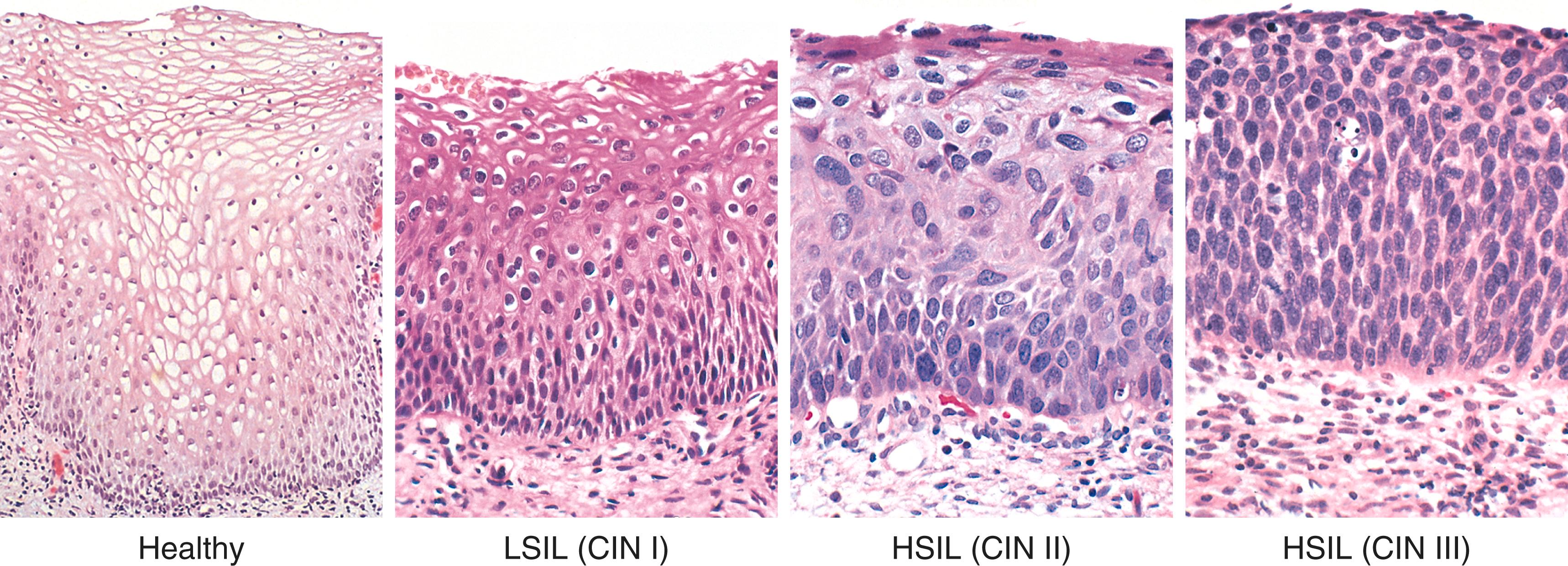

SIL is asymptomatic and comes to clinical attention through an abnormal Pap test result. Such cases are followed up by colposcopy, in which acetic acid identifies lesions for biopsy. Women with biopsy-documented LSIL are managed conservatively with careful observation, whereas HSILs and persistent LSIL are treated with surgical excision (cone biopsy). Follow-up tests and clinical examination are required in patients with HSIL, as these women remain at risk for HPV-associated cervical, vulvar, and vaginal cancers.
The most common cervical carcinomas are squamous cell carcinoma (80%), followed by adenocarcinoma and mixed adenosquamous carcinoma (15%) and small cell neuroendocrine carcinoma (<5%), all caused by high-risk HPV. The proportion of adenocarcinoma has been increasing in recent decades due to the decreasing incidence of invasive squamous carcinoma and the limited ability of the Pap test to detect precancerous glandular lesions.
Squamous cell carcinoma incidence peaks at the age of about 45 years, some 10 to 15 years after the peak incidence of SIL. As already discussed, progression of SIL to invasive carcinoma is variable and unpredictable, and while HPV infection is necessary, it is not sufficient; dysregulation of oncogenes at the site of viral DNA insertion or accumulation of additional mutations acquired during increased cellular proliferation contribute to malignant transformation by HPV. Although risk factors (discussed previously) may help identify patients who are likely to progress from SIL to carcinoma, the only reliable way to monitor the disease course is with frequent physical examinations coupled with Pap tests and biopsy of suspicious lesions.
Invasive carcinomas of the cervix develop in the transformation zone and range from microscopic foci of stromal invasion to grossly conspicuous exophytic tumors ( Fig. 17.8 ). Microscopically, the invasive tumors often consist of tongues and nests of squamous cells that produce a desmoplastic stromal response. Grading is based on the degree of squamous differentiation, which ranges from minimal to well-differentiated tumors that elaborate keratin pearls. Rare tumors with neuroendocrine differentiation resemble small cell carcinoma of the lung morphologically. Tumors encircling the cervix and penetrating into the underlying stroma produce a barrel cervix, which can be identified by direct palpation. Extension into the parametrial soft tissues can affix the uterus to the surrounding pelvic structures. The likelihood of spread to pelvic lymph nodes correlates with the depth of tumor invasion and the presence of tumor cells in vascular spaces. The risk of metastasis increases from less than 1% for tumors less than 3 mm in depth to more than 10% after invasion exceeds 3 mm.
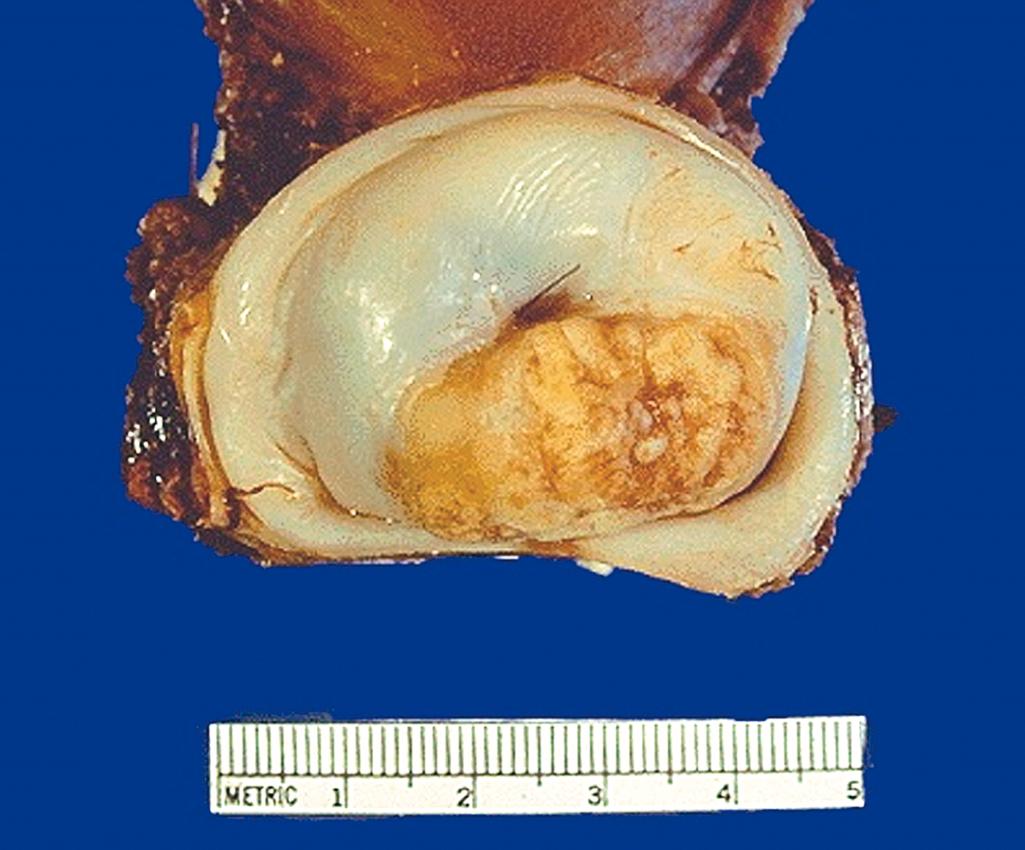
Invasive cervical cancer is most often diagnosed in patients who have never had a Pap test or who have not been screened for many years. Cervical cancer is often symptomatic, with patients coming to medical attention for unexpected vaginal bleeding, leukorrhea, dyspareunia (painful coitus), or dysuria. The primary treatment is hysterectomy and lymph node dissection; small microinvasive carcinomas may be treated with cone biopsy. Radiation and chemotherapy are of benefit when surgery alone is not curative. The prognosis for invasive carcinoma depends on the stage of the cancer at diagnosis and to some degree on histologic subtype, with small cell neuroendocrine tumors having a very poor prognosis.
The body (corpus) of the uterus is composed of the endometrium (glands and stroma) and the myometrium (smooth muscle). The more frequent and significant disorders of the uterus are considered here.
Inflammation of the endometrium is classified as acute or chronic depending on whether a neutrophilic or a lymphoplasmacytic infiltrate predominates, respectively. Acute endometritis is uncommon and limited to bacterial infections that arise after delivery or miscarriage. The diagnosis of chronic endometritis generally requires the presence of plasma cells, as lymphocytes are present even in the healthy endometrium. Tuberculosis causes granulomatous endometritis , often associated with tuberculous salpingitis and peritonitis.
Endometritis is a component of pelvic inflammatory disease and is frequently a result of N. gonorrhoeae or C. trachomatis infection. In the United States, tuberculous endometritis is mainly seen in individuals who are immunocompromised. It is more common in countries where tuberculosis is endemic and should be considered in the differential diagnosis of pelvic inflammatory disease in recent emigrants from endemic areas. All forms of endometritis manifest with fever, abdominal pain, and menstrual abnormalities.
Adenomyosis refers to the presence of endometrial tissue in the myometrium. Nests of endometrial stroma, glands, or both are found deep in the myometrium interposed between muscle bundles. The endometrial tissue induces reactive hypertrophy of the myometrium, resulting in an enlarged, globular uterus, often with a thickened uterine wall. Extensive adenomyosis may cause menorrhagia, dysmenorrhea, and pelvic pain, particularly just prior to menstruation, and can coexist with endometriosis.
Endometriosis is defined by the presence of endometrial glands and stroma in a location outside the uterus. It occurs in as many as 10% of women in their reproductive years and in nearly half of women with infertility. It is frequently multifocal and often involves pelvic structures (e.g., ovaries, pouch of Douglas, uterine ligaments, fallopian tubes). Less frequently, distant areas of the peritoneal cavity, periumbilical tissues, or laparotomy scars are involved. There are three types of endometriosis: superficial peritoneal endometriosis, ovarian endometriosis, and deep infiltrating endometriosis. Risk of malignant transformation is mainly confined to deep infiltrating endometriosis.
The pathogenesis of endometriosis remains elusive. Proposed origins fall into two main categories: (1) those that propose an origin from the uterine endometrium and (2) those that propose an origin from cells outside the uterus that have the capacity to give rise to endometrial tissue. The leading theories are as follows:
The regurgitation theory proposes that endometrial tissue implants at ectopic sites via retrograde flow of menstrual endometrium through the opening of the fallopian tube.
The benign metastasis theory holds that endometrial tissue from the uterus can “spread” to distant sites (e.g., bone, lung, and brain) via blood vessels and lymphatic channels.
The metaplastic theory suggests that endometrium arises directly from coelomic epithelium (mesothelium of pelvis or abdomen), from which the müllerian ducts and ultimately the endometrium originate during embryonic development. In addition, mesonephric remnants may undergo endometrial differentiation and give rise to ectopic endometrial tissue.
The extrauterine stem/progenitor cell theory proposes that stem/progenitor cells from the bone marrow differentiate into endometrial tissue.
Studies reveal that endometrial implants are not just misplaced but have different characteristics than eutopic uterine endometrium ( Fig. 17.9 ). Endometriotic tissue exhibits increased levels of proinflammatory and angiogenic factors, including prostaglandin E 2 , vascular endothelial growth factor (VEGF), and matrix metalloproteinases (MMP), some of which are released by macrophages that are recruited to endometriotic implants by proinflammatory factors. Endometriotic stromal cells make high levels of aromatase, leading to increased local production of estrogen from androgens.
Endometriosis typically consists of functioning endometrium, which undergoes cyclic bleeding. Because blood collects in these aberrant foci, they appear grossly as red-brown nodules or implants, ranging in size from microscopic to 1 to 2 cm in diameter, that lie on or just under the affected serosal surface. When lesions are widespread, organizing hemorrhage can cause extensive fibrous adhesions between fallopian tubes, ovaries, and other structures and obliterate the pouch of Douglas. The ovaries may become markedly distorted by large cystic masses (3 to 5 cm in diameter) filled with brown fluid resulting from previous hemorrhage; these are referred to as chocolate cysts or endometriomas ( Fig. 17.10 ). Diagnosis depends on finding both endometrial glands and stroma at sites external to the endometrium.
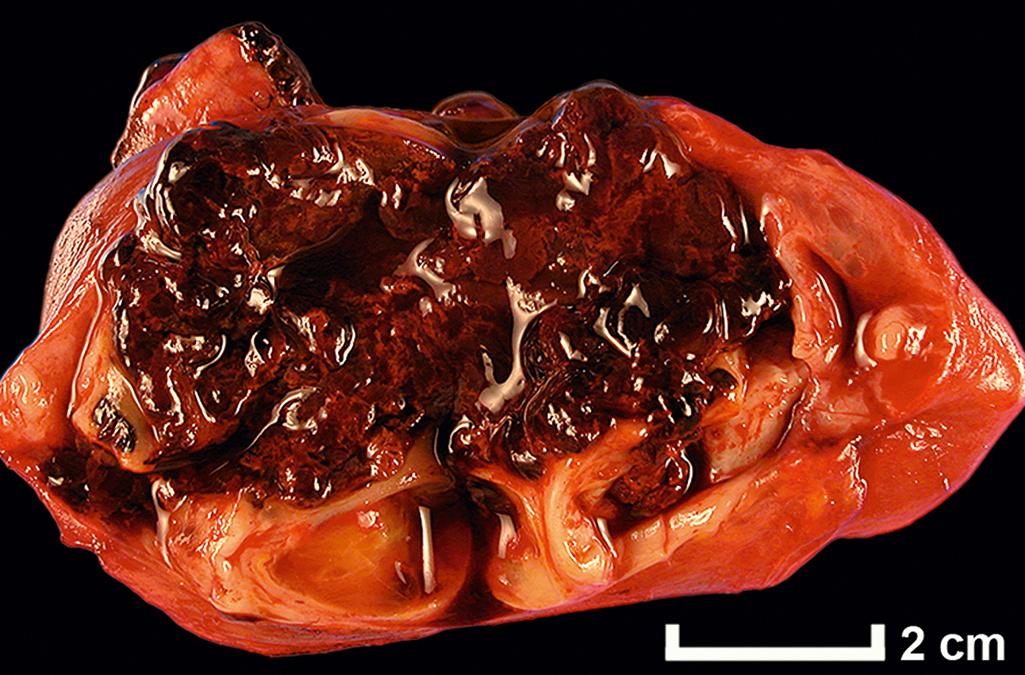

Clinical signs and symptoms usually include severe dysmenorrhea, dyspareunia, and pelvic pain due to intrapelvic bleeding and periuterine adhesions. Menstrual irregularities are common, and infertility is the presenting issue for 30% to 40% of patients. Effective treatments include COX-2 inhibitors and aromatase inhibitors. Although uncommon, malignancies can develop within endometriotic tissue.
Although abnormal uterine bleeding (e.g., menorrhagia [heavy menstrual bleeding], metrorrhagia [intermenstrual irregular bleeding], and postmenopausal bleeding) can arise in the setting of well-defined pathologic conditions, such as chronic endometritis, endometrial polyps, submucosal leiomyomas, or endometrial neoplasms, it most commonly stems from hormonal disturbances that produce dysfunctional uterine bleeding ( Table 17.2 ). Dysfunctional uterine bleeding is a clinical term for uterine bleeding that lacks an underlying structural abnormality. The most common cause of dysfunctional uterine bleeding is anovulation (failure to ovulate). Anovulatory cycles result from hormonal imbalances and are most common at menarche and in the perimenopausal period due to fluctuations in the hypothalamus/pituitary/ovarian axis. Less common causes of anovulation include the following:
Endocrine disorders, such as pituitary tumors that secrete prolactin, which disrupts gonadotropin releasing hormone (GnRH) secretion, thereby reducing levels of luteinizing hormone (LH) and follicle stimulating hormone (FSH)
Ovarian lesions, such as a functioning ovarian tumor (granulosa cell tumors) or polycystic ovarian syndrome (see later)
Generalized metabolic disturbances, such as obesity, malnutrition, or other chronic systemic disorders
| Age Group | Cause(s) |
|---|---|
| Prepuberty |
|
| Adolescence |
|
| Reproductive age |
|
| Perimenopause |
|
| Postmenopause |
|
Dysfunctional uterine bleeding may also result from an inadequate luteal phase (luteal phase defect) , which is thought to stem from insufficient production of progesterone by the corpus luteum.
The most common proliferative lesions of the uterine corpus are endometrial hyperplasia, endometrial carcinoma, endometrial polyps, and smooth muscle tumors. All tend to produce abnormal uterine bleeding as their earliest manifestation.
An excess of estrogen relative to progestin, if sufficiently prolonged or marked, can induce exaggerated endometrial proliferation (hyperplasia), which is an important precursor of endometrial carcinoma. A common cause of estrogen excess is obesity, as adipose tissue converts steroid precursors into estrogens. Other causes of estrogen excess include prolonged administration of estrogenic steroids without counterbalancing progestin and estrogen-producing ovarian lesions (such as polycystic ovarian syndrome and granulosa-theca cell tumors of the ovary).
Endometrial hyperplasia takes two forms, hyperplasia without atypia and hyperplasia with atypia. Hyperplasia without atypia has a wide range of appearances, but the cardinal feature is an increased gland to stroma ratio ( Fig. 17.11 A). Hyperplasia with atypia additionally shows complex patterns of proliferating glands with nuclear atypia ( Fig. 17.11 B, C). It is now appreciated that endometrial hyperplasia with atypia is associated with acquired clonal mutations in cancer genes, particularly mutations in the tumor suppressor gene PTEN , a feature that is shared with endometrial carcinoma. For this reason, it is considered a precursor of carcinoma and is commonly referred to as endometrial intraepithelial neoplasia (EIN). Because of this association, when atypia is identified the specimen must be carefully evaluated to exclude invasive cancer. Hysterectomy is the treatment for patients no longer desiring fertility; in younger patients, treatment with high-dose progestins may be attempted to preserve the uterus. By contrast, hyperplasia without cellular atypia carries a low risk (between 1% and 3%) for progression to endometrial carcinoma.
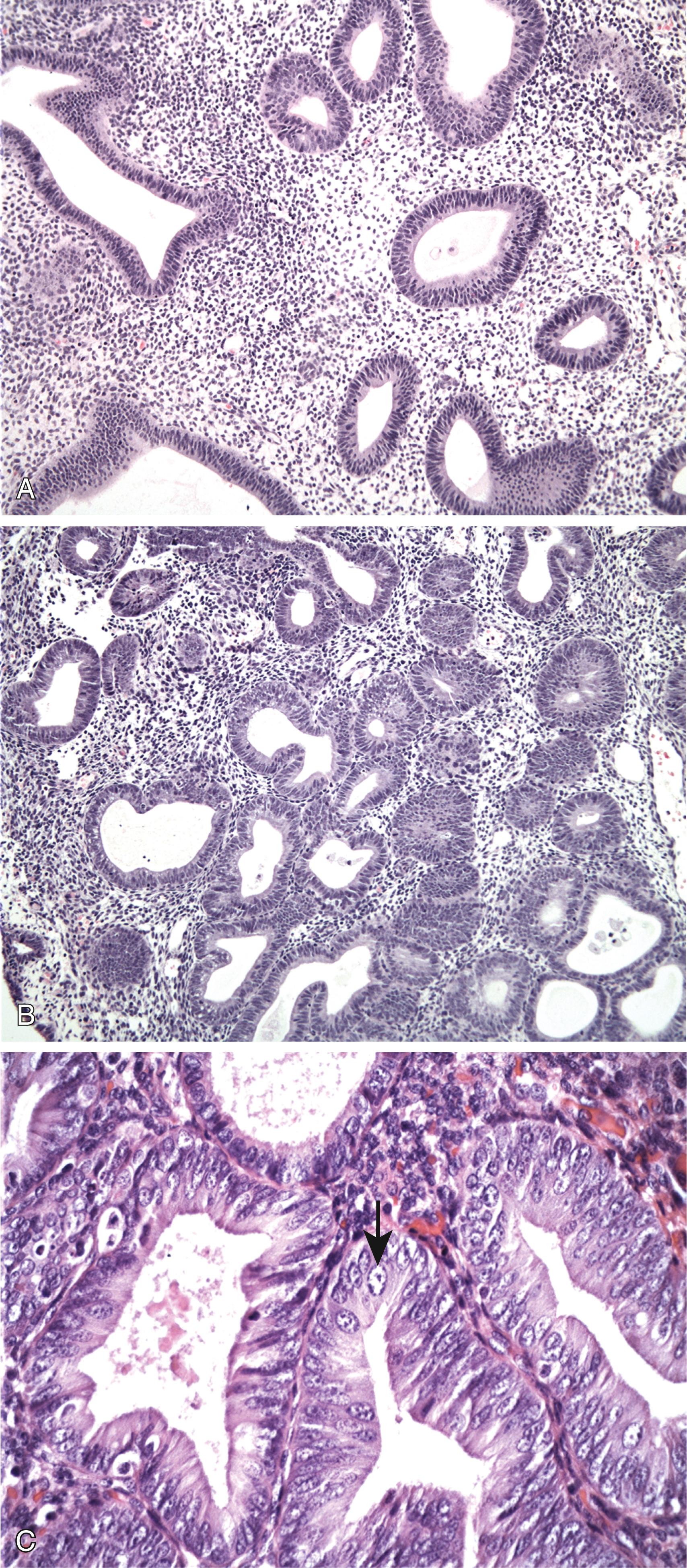
In higher-income countries, endometrial carcinoma is the most frequent cancer occurring in the female genital tract. Endometrial carcinoma is broadly divided into two histologically and pathogenically distinct categories: endometrioid and serous carcinoma. There are other less common types of endometrial carcinoma, such as clear cell carcinoma and mixed Müllerian tumor (carcinosarcoma), but these are too rare to merit further discussion.
Become a Clinical Tree membership for Full access and enjoy Unlimited articles
If you are a member. Log in here